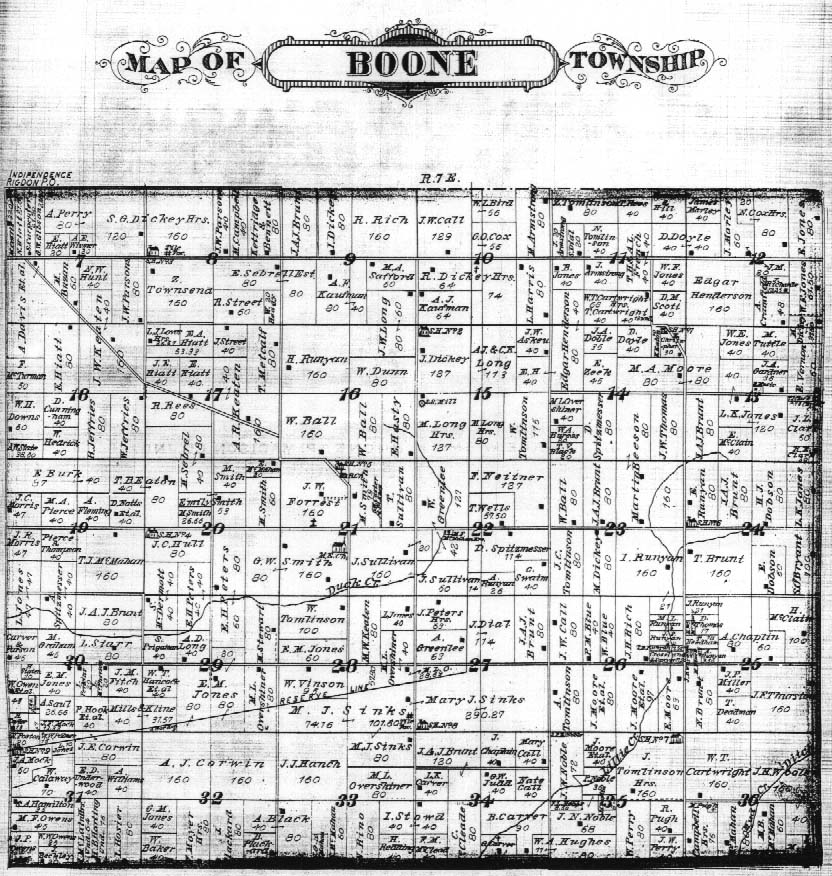|
Pioneer
Cemeteries and Their Stories, Madison County, Indiana |
 |
|
Pioneer
Cemeteries and Their Stories, Madison County, Indiana |
 |
Boone Township--Wright Smith 1835
|
The first settler to this township Wright Smith is buried at the Forrestville Cemetery. His large pillared gravestone is pictured at right. It overlooks a beautiful expanse of Boone Township farmland that was once part of the Miami Indian Reserve. Wright Smith came from Virginia, via Rush County, Indiana, in the fall of 1835 with his wife and six children. He built the first domicile, a log cabin, of course, and "died December 23, 1863, aged 65Y 7M 1D." |
 |
Boone Township is named for the frontiersman Daniel Boone. It is in the center of the northern boundary of Madison County and is one of the later developing areas because a large section was once part of the Miami Indian Reserve. When the remaining Native Americans were moved out of state in the mid 1830s, the land was opened for development. The first settler to the township was Wright Smith. He was born in 1798 in Virginia. He, along with his wife Lydia and six children, came in 1835. Other than his farming enterprises, Wright Smith helped organize in 1851 one of the first churches in the township, the Methodist Episcopal. Smith was elected class leader and erected a house of worship for the congregation at his own expense. He also served as superintendent of the church's Sunday school, a position he held for ten years until his death in 1863. Wright Smith was described by county historian Samuel Harden as "tall, slim, with dark complexion and dark hair... He was on the right side of all moral questions. His memory should be kept green for the sterling qualities and noble ambition, which were characteristic of the man."
|
|
|
|
In Boone Township on CR 400W between 1400N and 1500N are the remnants of the surveyed line that marked the southern boundary of the Miami Indian Reservation: at left the large stone with incised GMB (Government Marker Boundary) and at right the line of sight, looking east, still indicated by the division between two fields. (Photos courtesy of Stephen Jackson, Madison County Historian)
Continuing in his father's walk of life, son George W. Smith was featured in the 1880 History of Madison County as an exemplary farmer from Boone Township. A picture of the George Smith farm and the Smith Chapel, erected by the father, are on page 96. The following excerpt, in the semantics and phrasing of the 19th century, describes part of what George and his parents faced as the township's first family:
"The Smith family...were the first to lead the way to a wilderness home in this township. From their axes reverberated the first musical notes of civilization in that deep, wild, lonesome forest; above their cabin home curled the first smoke from the fire that warmed the white man and cooked his repast... They found this township the abode of the red man and inhabited by his pets, the deer, wolf, and bear; the deer galloped in glee at the warbling of the wood songsters in the boughs over their heads; the barking and the howling of the wolf made many a night hideous in the ears of those who ventured not [far] from their rude-guilt homes, in this pathless wood; and unsociable old bruin walked about in silence and boldness, on the leafy carpets of his native home. What barriers in the way to these new-comers! To make a home here in this vast and untraversed wilderness required stout and brave hearts with determined and unflinching purposes. It made self-denial an uncompromising necessity. Amidst scenes wild, daring and adventurous, George passed his boyhood and his youthful days.
"Mr. Smith [George] early in life decided to follow the occupation of this father, viz., that of farming. That he has made a grand success is attested by a farm of 240 acres, in his possession, well tilled and finely improved, and around his home we find hogs, sheep, cattle and horses of the best-improved breeds. His motto is, the 'best.' He was joined in wedlock with Miss Elizabeth Austin... The fruits of this union have been eight children... Mr. Smith and his devoted wife walked hand in hand in their religious life, and he still clings to the faith of the Cross...and by his straightforwardness he commands the respect and confidence of those who have long known him."
George Smith, 1830-1883, who had entered Boone Township with his father Wright and mother Lydia when he was six, died three years after the biography was written and is buried, along with several of his children who died in infancy, at the Mt. Tabor Cemetery across the township line in Monroe Township.
Following the Smith family into Boone Township in the mid 1830s were these settlers: Eli Freestone, Elijah Ward, Thomas Brunt, Peter Eaton, James and John Tomlinson, Bryant Ellis, D. Doyle, William Reavis, Enoch and Morgan McMahan, John Moore, and their families.
Only four pioneer cemeteries are listed for this township: Carver, Dickey, Forrestville, and Rigdon/Knox Chapel/Independence. The 1876 Boone Township plat map below shows the Smith family property in section 21. The Methodist Episcopal Church that Wright Smith helped start is clearly marked. North of the Smith farm is the Forrest property with its own church, cemetery, and school house #5. (For the story of the Forrest family, go to the Forrestville Cemetery page.) Also, the boundary lines for the Miami Indian Reserve are shown starting from section 27, running southwest and straight north.
Click here for modern map of township pioneer cemeteries.
